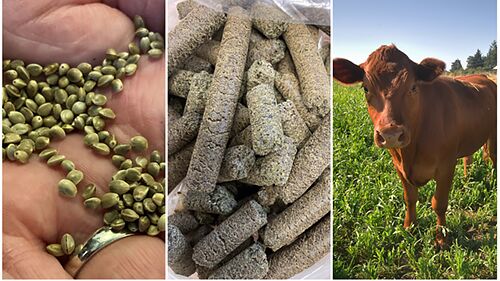Cowherds are facing challenging times. Forages are hard to come by. Pastures in some areas need to rest due to drought stress. Cow-calf producers would like to hold on to their herds and are searching for a way to keep those genetics intact.
Jason Warner, Kansas State University Extension beef cow-calf specialist suggested limit feeding. It’s not a new practice in the beef industry, but it’s one that can be very effective for cow-calf herds. More commonly used in backgrounding or growing operations, limit feeding has seen some research trials over the last 20 or 30 years he said.
Limit feeding is feeding a limited amount of high energy ration. Not necessarily a high-concentrate ration, but a high energy ration to achieve a targeted maintenance level for cows in order to maintain body weight and body condition score.
“It’s truly a very effective strategy for minimizing harvested forage needs and, ultimately, reducing our cost per cow per day,” he said.
Feed ingredients need to be priced out on a cost per unit of energy basis—whether it is analyzed on a total digestible nutrient basis or an energy basis, it needs to be looked at in a limit feeding situation.
“We’re trying to fill that ration or build that ration around whatever is the most economical ingredient for us to use from a cost per unit of energy basis,” he said.
There are some benefits to limit feeding that may not be apparent up front. In backgrounding or growing operations and on the finishing side, any time animals are on a restricted feeding program, it reduces the manure output.
In typical feeding programs on cow-calf operations, when cattle are managed out on pasture or on calving and feeding grounds, feed trampling and wastage contributes to fly loads and populations. During spring and early summer, flies have an impact on animal performance.
Keep that in mind as animals are usually going to be restricted to maybe three-fourths or a little bit less of their ad libitum intake. Those producers who grow or finish cattle understand that, but when applying this to a ranch or cow-calf production system it’s not often thought of in those terms.
“Just as an example, if we think about situations where we would have a cow that’s going to be consuming 26 pounds of dry matter, three-fourths of that would be 19 and a half pounds of dry matter intake. So it’s a targeted amount of energy to maintain weight and condition,” he said. “But we know that intake is going to be less.”
Warner said the animals on a limited feeding ration will quickly consume what they would need on a daily basis. That’s why having adequate bunk space is so important. From a production standpoint, for limit feeding to be effective producers should address a couple things.
“Facilities is key” in a limit-fed situation, he said. Make sure fences are good and facilities are in order to contain the calves and have plenty of bunk space for cows and calves. A minimum of 24 inches of linear bunk space per mature female is suggested. Probably should be closer to 36 inches or more if there are calves at their sides.
“Cows are going to be discontent the first week to maybe two weeks when you first implement that type of a program with them,” Warner said. “One thing that might be beneficial is if you start out with a higher level of intake. Fill those animals up on hay initially and then progressively and gradually work intake back and work intake down.”
Warner believes this helps cows adjust to the program more readily and he’s observed when programs like this are implemented, the cattle will adjust accordingly.
Equipment is important as well and having the ability to mix and deliver diets reliably is crucial.
Sorting cows is really important before beginning a limit feeding scenario. If a producer can sort by age and the size of the herd, it’s critical to do so.
“What we’re doing there is if we can sort those more dominant older cows from those more timid females, we can help just minimize the variation that we might see there in terms of weight and body condition score,” he said.
Warner said there are a couple decision support tools available on ksubeef.org, that can be helpful for producers needing to make decisions like this.
When faced with having to limit feed a cow herd, Warner said it really comes down to, in his mind, three big things—facilities, equipment and management.
“If you can be consistent with how you deliver that ration out there to those cows, and it fits your overall management style, I think it’s certainly an option that can be very effective in managing cows through situations where we’ve got limited forage resources.”
Kylene Scott can be reached at 620-227-1804 or [email protected].




